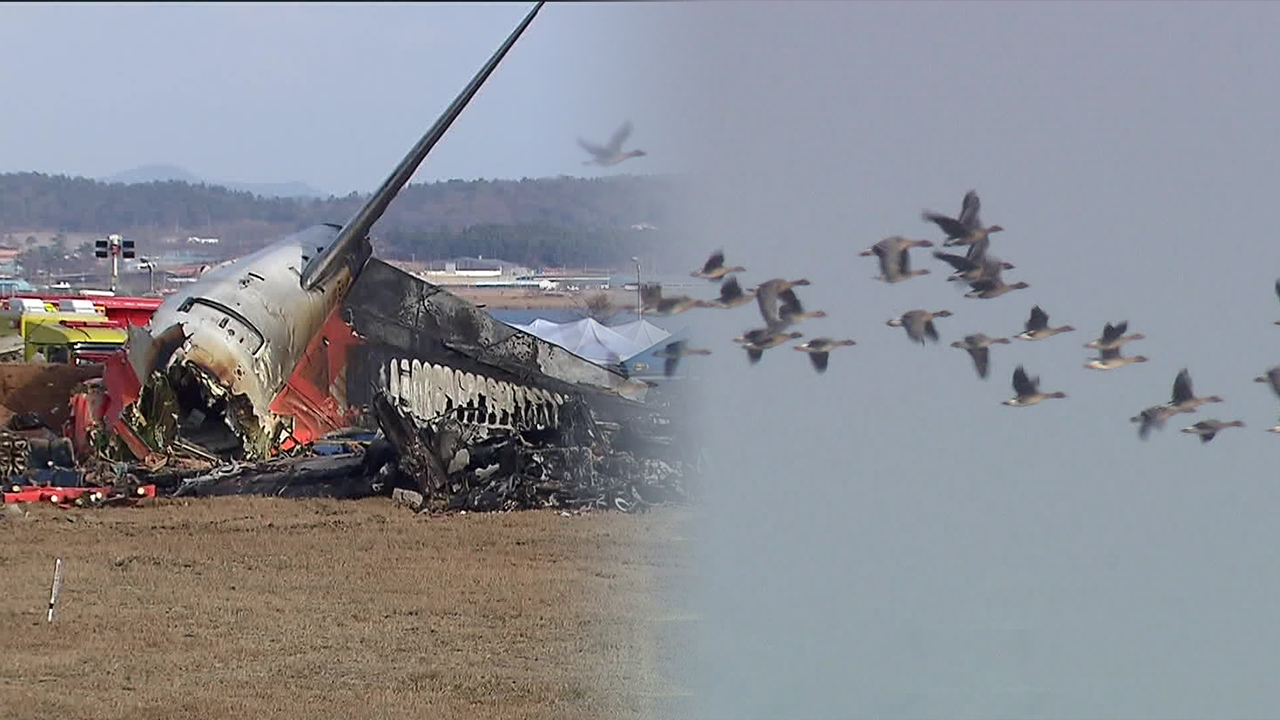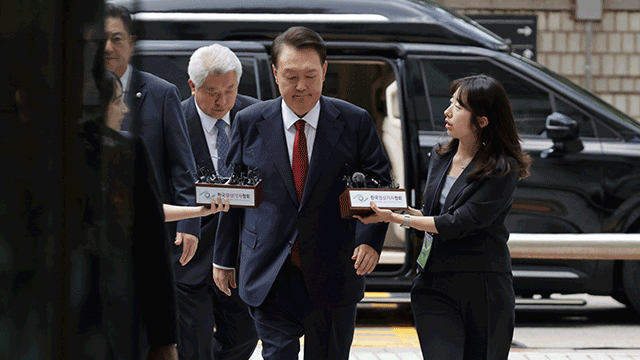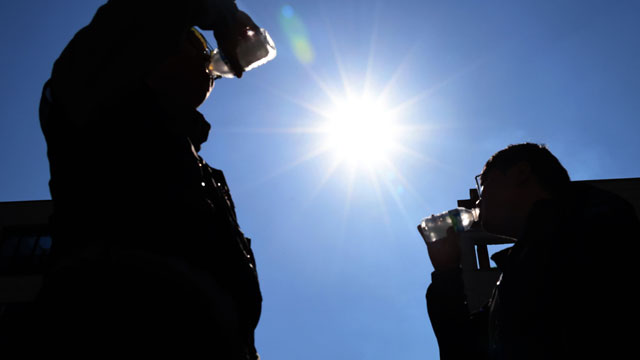Eco assessment warned of bird strike risk
입력 2024.12.31 (00:04)
읽어주기 기능은 크롬기반의
브라우저에서만 사용하실 수 있습니다.
[Anchor]
The primary cause of this disaster is strongly identified as a bird strike, as you have just seen.
Muan International Airport is surrounded by migratory bird habitats, and the risk was warned about in an environmental impact assessment conducted two years ago.
Reporter Kim Se-hyun has the story.
[Report]
Dozens of birds are flying in flocks around Muan International Airport, where efforts to manage the aftermath of the accident are underway.
In a photo taken the day before the accident, large flocks of birds are clearly visible around the airport.
[Lee Gi-woo/Resident near Muan International Airport: "In winter, many migratory birds come through. It seems that geese and ducks and other types of birds are flying around in groups, about dozens at a time."]
The National Institute of Ecology also observed over 7,000 migratory birds of 79 species near the airport in Hyeonggyeong and Unnam-myeon last December.
There has always been a possibility of bird strikes.
Concerns were also raised in the environmental impact assessment conducted two years ago for the expansion of the airport runway.
According to the evaluation report, four migratory bird habitats were identified within 13 km of Muan International Airport, surrounding the airport.
The report emphasized the need for measures to minimize bird strikes, noting the presence of various birds such as large geese and storks.
Many airports in South Korea are located far from cities in plains or coastal areas due to noise and safety issues.
This creates a favorable environment for wild birds like migratory birds to inhabit away from humans.
[Lee Geun-young/Professor of Flight Operation at Korea National University of Transportation: "Airports tend to be located near coastlines, and migratory birds prefer these areas because they avoid densely populated regions and have better breeding conditions. The overlap of these areas creates problems."]
Because of this, the possibility of bird strikes has been a topic of controversy every time a new airport site is selected.
This is KBS News, Kim Se-hyun.
The primary cause of this disaster is strongly identified as a bird strike, as you have just seen.
Muan International Airport is surrounded by migratory bird habitats, and the risk was warned about in an environmental impact assessment conducted two years ago.
Reporter Kim Se-hyun has the story.
[Report]
Dozens of birds are flying in flocks around Muan International Airport, where efforts to manage the aftermath of the accident are underway.
In a photo taken the day before the accident, large flocks of birds are clearly visible around the airport.
[Lee Gi-woo/Resident near Muan International Airport: "In winter, many migratory birds come through. It seems that geese and ducks and other types of birds are flying around in groups, about dozens at a time."]
The National Institute of Ecology also observed over 7,000 migratory birds of 79 species near the airport in Hyeonggyeong and Unnam-myeon last December.
There has always been a possibility of bird strikes.
Concerns were also raised in the environmental impact assessment conducted two years ago for the expansion of the airport runway.
According to the evaluation report, four migratory bird habitats were identified within 13 km of Muan International Airport, surrounding the airport.
The report emphasized the need for measures to minimize bird strikes, noting the presence of various birds such as large geese and storks.
Many airports in South Korea are located far from cities in plains or coastal areas due to noise and safety issues.
This creates a favorable environment for wild birds like migratory birds to inhabit away from humans.
[Lee Geun-young/Professor of Flight Operation at Korea National University of Transportation: "Airports tend to be located near coastlines, and migratory birds prefer these areas because they avoid densely populated regions and have better breeding conditions. The overlap of these areas creates problems."]
Because of this, the possibility of bird strikes has been a topic of controversy every time a new airport site is selected.
This is KBS News, Kim Se-hyun.
■ 제보하기
▷ 카카오톡 : 'KBS제보' 검색, 채널 추가
▷ 전화 : 02-781-1234, 4444
▷ 이메일 : kbs1234@kbs.co.kr
▷ 유튜브, 네이버, 카카오에서도 KBS뉴스를 구독해주세요!
- Eco assessment warned of bird strike risk
-
- 입력 2024-12-31 00:04:27

[Anchor]
The primary cause of this disaster is strongly identified as a bird strike, as you have just seen.
Muan International Airport is surrounded by migratory bird habitats, and the risk was warned about in an environmental impact assessment conducted two years ago.
Reporter Kim Se-hyun has the story.
[Report]
Dozens of birds are flying in flocks around Muan International Airport, where efforts to manage the aftermath of the accident are underway.
In a photo taken the day before the accident, large flocks of birds are clearly visible around the airport.
[Lee Gi-woo/Resident near Muan International Airport: "In winter, many migratory birds come through. It seems that geese and ducks and other types of birds are flying around in groups, about dozens at a time."]
The National Institute of Ecology also observed over 7,000 migratory birds of 79 species near the airport in Hyeonggyeong and Unnam-myeon last December.
There has always been a possibility of bird strikes.
Concerns were also raised in the environmental impact assessment conducted two years ago for the expansion of the airport runway.
According to the evaluation report, four migratory bird habitats were identified within 13 km of Muan International Airport, surrounding the airport.
The report emphasized the need for measures to minimize bird strikes, noting the presence of various birds such as large geese and storks.
Many airports in South Korea are located far from cities in plains or coastal areas due to noise and safety issues.
This creates a favorable environment for wild birds like migratory birds to inhabit away from humans.
[Lee Geun-young/Professor of Flight Operation at Korea National University of Transportation: "Airports tend to be located near coastlines, and migratory birds prefer these areas because they avoid densely populated regions and have better breeding conditions. The overlap of these areas creates problems."]
Because of this, the possibility of bird strikes has been a topic of controversy every time a new airport site is selected.
This is KBS News, Kim Se-hyun.
The primary cause of this disaster is strongly identified as a bird strike, as you have just seen.
Muan International Airport is surrounded by migratory bird habitats, and the risk was warned about in an environmental impact assessment conducted two years ago.
Reporter Kim Se-hyun has the story.
[Report]
Dozens of birds are flying in flocks around Muan International Airport, where efforts to manage the aftermath of the accident are underway.
In a photo taken the day before the accident, large flocks of birds are clearly visible around the airport.
[Lee Gi-woo/Resident near Muan International Airport: "In winter, many migratory birds come through. It seems that geese and ducks and other types of birds are flying around in groups, about dozens at a time."]
The National Institute of Ecology also observed over 7,000 migratory birds of 79 species near the airport in Hyeonggyeong and Unnam-myeon last December.
There has always been a possibility of bird strikes.
Concerns were also raised in the environmental impact assessment conducted two years ago for the expansion of the airport runway.
According to the evaluation report, four migratory bird habitats were identified within 13 km of Muan International Airport, surrounding the airport.
The report emphasized the need for measures to minimize bird strikes, noting the presence of various birds such as large geese and storks.
Many airports in South Korea are located far from cities in plains or coastal areas due to noise and safety issues.
This creates a favorable environment for wild birds like migratory birds to inhabit away from humans.
[Lee Geun-young/Professor of Flight Operation at Korea National University of Transportation: "Airports tend to be located near coastlines, and migratory birds prefer these areas because they avoid densely populated regions and have better breeding conditions. The overlap of these areas creates problems."]
Because of this, the possibility of bird strikes has been a topic of controversy every time a new airport site is selected.
This is KBS News, Kim Se-hyun.
-
-

김세현 기자 weather@kbs.co.kr
김세현 기자의 기사 모음
-
이 기사가 좋으셨다면
-
좋아요
0
-
응원해요
0
-
후속 원해요
0















이 기사에 대한 의견을 남겨주세요.